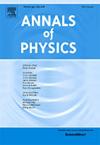Transmission and quasinormal modes of massive vector field in (2+1)-dimensional static wormhole in vacuum
IF 3
3区 物理与天体物理
Q2 PHYSICS, MULTIDISCIPLINARY
引用次数: 0
Abstract
This investigation examines the behavior of a massive vector field in the context of a 2+1-dimensional static wormhole in vacuum, with a focus on both transmission characteristics and quasinormal modes (QNMs). Using the Duffin–Kemmer–Petiau (DKP) equation to describe the massive vector field, analytical expressions for the transmission coefficients are derived, and the QNMs are identified as the complex poles of these coefficients. The analysis demonstrates that the transmission varies significantly with the angular momentum and throat and curvature radii of the wormhole, with modes exhibiting higher transmission rates. Regarding the QNMs, it was shown that for , the system can transition between evanescent and propagative modes depending on the mass threshold of the vector field. However, for , the system, in addition to exhibiting long-lived modes when the mass is large, does not exhibit anomalous behavior in the decay rate for any overtone value. These findings provide insights into the response dynamics of static wormholes in vacuum under perturbations of massive vector fields, contributing to a more comprehensive understanding of exotic space-time geometries.
真空(2+1)维静态虫洞中大质量矢量场的传输和准正态模态
本研究考察了真空中2+1维静态虫洞中大质量矢量场的行为,重点研究了传输特性和准正态模式(QNMs)。利用Duffin-Kemmer-Petiau (DKP)方程描述大质量矢量场,推导了传输系数的解析表达式,并将传输系数的复数极点识别为qnm。分析表明,传输速率随虫洞的角动量、喉道半径和曲率半径的变化有显著的变化,其中以r =0模式传输速率较高。对于QNMs,我们证明了当r =0时,系统可以根据矢量场的质量阈值在倏逝模式和传播模式之间转换。然而,当r≥1时,系统除了在质量较大时表现出长寿命模式外,在任何泛音值的衰减率中都没有表现出异常行为。这些发现提供了对真空中静态虫洞在大质量矢量场扰动下的响应动力学的见解,有助于更全面地理解奇异的时空几何。
本文章由计算机程序翻译,如有差异,请以英文原文为准。
求助全文
约1分钟内获得全文
求助全文
来源期刊

Annals of Physics
物理-物理:综合
CiteScore
5.30
自引率
3.30%
发文量
211
审稿时长
47 days
期刊介绍:
Annals of Physics presents original work in all areas of basic theoretic physics research. Ideas are developed and fully explored, and thorough treatment is given to first principles and ultimate applications. Annals of Physics emphasizes clarity and intelligibility in the articles it publishes, thus making them as accessible as possible. Readers familiar with recent developments in the field are provided with sufficient detail and background to follow the arguments and understand their significance.
The Editors of the journal cover all fields of theoretical physics. Articles published in the journal are typically longer than 20 pages.
 求助内容:
求助内容: 应助结果提醒方式:
应助结果提醒方式:


